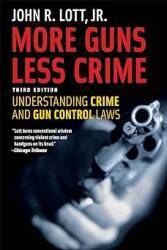
Be Careful, Stay Legal
Section 922R Compliance For Your Rifle
Section 922R Compliance For Your Rifle
Title 18 U.S. Code, Chapter 44, Section 922 defines what is and is not legal to assemble from a collection of parts. If you are starting with a foreign parts kit, the important point is that there is a list of 20 parts (not all of which exist on a given gun design), and you must use no more than ten foreign-made parts from that list. Be careful with the logic! Simply adding American-manufactured gadgets doesn't make it legal. You must replace some of the original parts to keep your rifle legal. Read on for the details, but first...
I am not a lawyer!
Do not take this page as legal advice!
Table of Contents
I am just presenting the U.S. regulations and passing along some interpretation I have read. This is not an attempt to offer legal advice.
For real answers, ask the Bureau of Alcohol, Tobacco, Firearms and Explosives.
You could ask the company selling the parts, but do remember that their primary goal is to sell gun parts. They have no authority to say what is and is not legal, while BATFE does.
The Summary
Guns "not being particularly suitable for or readily adaptable to sporting purposes", meaning foreign military surplus rifles, must contain no more than ten of the following imported parts.
| No more than ten of these imported parts: | |
| 1. | Frames, receivers, receiver castings, forgings or stampings |
| 2. | Barrels |
| 3. | Barrel extensions |
| 4. | Mounting blocks (trunions) |
| 5. | Muzzle attachments |
| 6. | Bolts |
| 7. | Bolt carriers |
| 8. | Operating rods |
| 9. | Gas pistons |
| 10. | Trigger housings |
| 11. | Triggers |
| 12. | Hammers |
| 13. | Sears |
| 14. | Disconnectors |
| 15. | Buttstocks |
| 16. | Pistol grips |
| 17. | Forearms, handguards |
| 18. | Magazine bodies |
| 19. | Followers |
| 20. | Floorplates |
Not every gun will have all twenty of these parts. Also remember that it's up to BATFE to decide what to call each little gadget.
Fair enough. After all, Mikhail Timofeevich Kalashnikov would insist that a crucial component of his design is properly called the Ствольная коробка, pronounced stvol'naya korobka. Literally, that's Russian for "barrel box". But for some reason we English speakers insist on calling it the "receiver". And even in English, what is the piece you use to work the bolt — is it the "operating rod", the "cocking handle", the "charging handle", the "bolt handle", or something else?
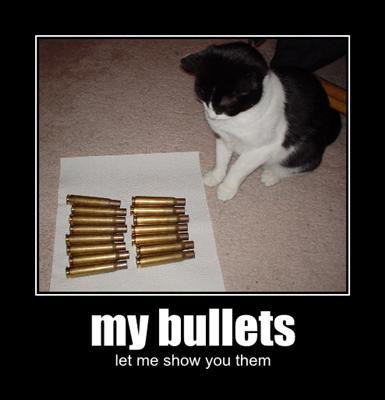
Maybe a silly picture of a cat will make it more clear that I am not a lawyer and you should not rely on this page for legal advice.
So, things do need formal labels, and they will seem kind of arbitrary at times, so you have to put up with BATFE sometimes putting names on things that might be a little different than what you would call it.
This actually works to your advantage. What people commonly call the Operating Rod on an SKS is labeled by BATFE as a Piston Extension. If they had called it an operating rod, it would be on this list and would count against you. Since they label it as a piston extension, which is not on the list, you come out ahead and have one less piece you must replace.
Notice that the crucial regulation, which is actually Title 27 CFR Section 478.39 (and see its text below if you want), says "imported parts". It doesn't say "original parts", as that would allow you to simply swap parts between two guns and magically make them legal by rearrangement. It says "imported", as in "not manufactured in the U.S." Whether they were imported in one parts kit, or imported separately, they are imported and you can only have 10 of them.
Don't Be Confused About the "Compliance Parts" Count
The law specifies the number of imported parts, no more than ten out of that list of twenty.
The law does not talk about U.S. parts. Many people misinterpret the law by counting U.S. parts, and from there it's an easy mistake to count irrelevant parts in some theorized tally of parts that help. "Look, I just put on a U.S.-made sling, and front sight post, and scope, and recoil pad!" Yeah, that's nice, but none of those matter. The law is about how many parts you replace to get the number from that list of controlled parts down to ten.
Another way people get confused by counting the U.S. parts is when they replace the removeable magazine. On the AK/AKM series, the FN FAL, and the G3/CETME, this eliminates three restricted imported parts: the magazine body, magazine follower, and magazine floorplate. "But when I remove the magazine to reload it, my gun has less U.S.-made parts in it and it is temporarily out of compliance!" No, that's not the way it works. Let's look at the parts counts for the AK/AKM series, the Saiga, the SKS, the Fabrique Nationale FAL, and the G3/CETME. The Saiga is a sporter version of the AK series, produced by Izhmash, and sometimes "restored" to build something similar to the AK-100 series rifles produced in the same Izhmash factory.
| Part | AK / AKM | Saiga | SKS | FN FAL | G3 / CETME |
| Frame, receiver, receiver casting, forging or stamping |
✔ | ✔ | ✔ | ✔ | ✔ |
| Barrel | ✔ | ✔ | ✔ | ✔ | ✔ |
| Barrel extension | |||||
| Mounting block (trunion) | ✔ [1] | ✔ | ✔ | ||
| Muzzle attachment | ✔ | [2] | ✔ | ✔ | ✔ |
| Bolt | ✔ | ✔ | ✔ | ✔ | ✔ |
| Bolt carrier | ✔ | ✔ | ✔ | ✔ | ✔ |
| Operating rod | ✔ | ✔ | |||
| Gas piston | ✔ | ✔ | ✔ | ✔ | |
| Trigger housing | ✔ | ✔ | ✔ | ||
| Trigger | ✔ | ✔ | ✔ | ✔ | ✔ |
| Hammer | ✔ | ✔ | ✔ | ✔ | ✔ |
| Sear | ✔ | ✔ | ✔ | ||
| Disconnector | ✔ | ✔ | ✔ | ||
| Buttstock | ✔ | ✔ | ✔ | ✔ | ✔ |
| Pistol grip | ✔ | [2] | ✔ | ✔ | |
| Forearm, handguard | ✔ | ✔ | ✔ | ✔ | ✔ |
| Magazine body | ✔ | ✔ | ✔ | ✔ | ✔ |
| Magazine follower | ✔ | ✔ | ✔ | ✔ | ✔ |
| Magazine floorplate | ✔ | ✔ | ✔ | ✔ | |
| Total | 16 | 14 | 15 | 17 | 17 |
| AK / AKM | Saiga | SKS | FN FAL | G3 / CETME | |
|
|||||
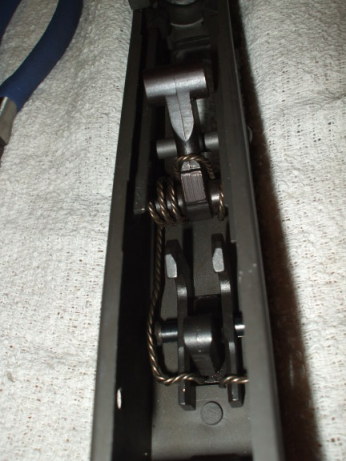
Trigger group and hammer from a U.S. factory, receiver bent in a U.S. shop, replacing three parts from the restricted list.
Let's say you're building an AK/AKM, which normally has 16 of these restricted parts. Notice that both the AK/AKM and Saiga are listed as having a trigger, hammer, and disconnector, but no sear. The BATFE has decided that the sear is part of the disconnector in the trigger groups of both. Again, an arbitrary decision works to the builder's advantage — that's one less imported part you have to replace.
You have to start the construction project by bending your own sheet metal receiver, as the original was cut in half with a torch before being exported. Then let's say that you add a U.S.-made pistol grip, trigger group (with trigger, disconnector, and hammer), and detachable magazine (with body, follower, and floorplate). Eight of the original sixteen restricted parts were replaced, getting you down to just eight restricted parts and you are compliant. If you take the magazine into the next room or leave it at the range, the gun still has just 8 restricted parts — the barrel, trunion, muzzle attachment (brake), bolt, bolt carrier, gas piston, buttstock, and forearm/handguard.
However, if you used that gun with an imported magazine, you would be back up to 11 and over the limit. So, replace the muzzle brake for just 7 restricted parts when used with a U.S. made magazine, and 10 with your buddy's imported magazine.
You can drop the count by one more by replacing the gas cylinder. Now you would be safe, one part beyond the requirement. You could drop the count two more with new "furniture", the forearm and buttstock.
In order to further protect U.S. industry, or at least the very narrow slice of it making AK-47 barrels, a trade regulation change around 2012 ended the import of barrels. So now another restricted part must be replaced in new projects.
The Legal Documents
Maybe that's all you were looking for, but let's wade in to the legal documents.
Firearms and Illegal Acts — Title 18 U.S. Code, Chapter 44, Section 922
The first document of interest is Title 18 U.S. Code (Crimes and Criminal Procedure), especially its Chapter 44 — Firearms. and especially that chapter's section 922, Unlawful Acts. The sections of Chapter 44 are:
| 921 | Definitions | |
| 922 | Unlawful acts. | |
| 923 | Licensing. | |
| 924 | Penalties. | |
| 925 | Exceptions: Relief from disabilities. | |
| 925A | Remedy for erroneous denial of firearm. | |
| 926 | Rules and regulations. | |
| 926A | Interstate transportation of firearms. | |
| 926B | Carrying of concealed firearms by qualified law enforcement officers. | |
| 926C | Carrying of concealed firearms by qualified retired law enforcement officers. | |
| 927 | Effect on State law. | |
| 928 | Separability. | |
| 929 | Use of restricted ammunition. | |
| 930 | Possession of firearms and dangerous weapons in Federal facilities. | |
| 931 | Prohibition on purchase, ownership, or possession of body armor by violent felons. |
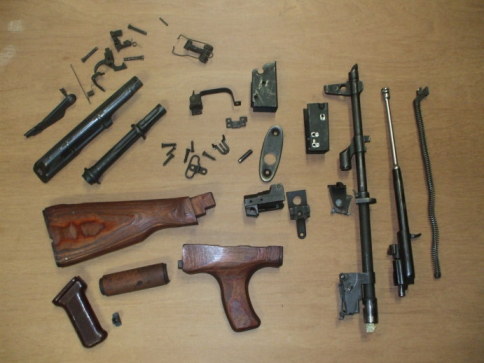
This Romanian AK/AKM parts kit contains everything except for some of the scrap from the center of the receiver. It should not have included all the parts of the trigger group!
Before starting, make sure you leave those serial numbers alone! 18 U.S.C. Chapter 44 section 922k says:
| (k) It shall be unlawful for any person knowingly to transport, ship, or receive, in interstate or foreign commerce, any firearm which has had the importer's or manufacturer's serial number removed, obliterated, or altered or to possess or receive any firearm which has had the importer's or manufacturer's serial number removed, obliterated, or altered and has, at any time, been shipped or transported in interstate or foreign commerce. |
What is illegal (and legal) to assemble? — 18 U.S.C. Chapter 44 Section 922r and 925d
Here is the crucial section of 18 U.S.C. Chapter 44. Section 922r says:
|
(r) It shall be unlawful for any person to assemble from imported parts any semiautomatic rifle or any shotgun which is identical to any rifle or shotgun prohibited from importation under section 925(d)(3) of this chapter as not being particularly suitable for or readily adaptable to sporting purposes except that this subsection shall not apply to - (1) the assembly of any such rifle or shotgun for sale or distribution by a licensed manufacturer to the United States or any department or agency thereof or to any State or any department, agency, or political subdivision thereof; or (2) the assembly of any such rifle or shotgun for the purposes of testing or experimentation authorized by the Attorney General. |
That leads us to section 925(d)(3). Good luck understanding this, the logic is complicated and there must have been a more clear way of wording this.
|
(d) The Attorney General shall authorize a firearm or ammunition to be imported or brought into the United States or any possession thereof if the firearm or ammunition - (1) is being imported or brought in for scientific or research purposes, or is for use in connection with competition or training pursuant to chapter 401 of title 10; (2) is an unserviceable firearm, other than a machinegun as defined in section 5845(b) of the Internal Revenue Code of 1986 (not readily restorable to firing condition), imported or brought in as a curio or museum piece; (3) is of a type that does not fall within the definition of a firearm as defined in section 5845(a) of the Internal Revenue Code of 1986 and is generally recognized as particularly suitable for or readily adaptable to sporting purposes, excluding surplus military firearms, except in any case where the Attorney General has not authorized the importation of the firearm pursuant to this paragraph, it shall be unlawful to import any frame, receiver, or barrel of such firearm which would be prohibited if assembled; or (4) was previously taken out of the United States or a possession by the person who is bringing in the firearm or ammunition. |
Prohibited firearms — Title 26 U.S. Code, Section 5845(a)
Section 5845(a) of Title 26 U.S. Code defines prohibited firearms in its subsection (a), and defines specific categories in the following subsections. Basically you cannot have:
- Shotguns shorter than 26" overall or with a barrel shorter than 18".
- Rifles shorter than 26" overall or with a barrel shorter than 16".
- Fully automatic guns.
- Pen-guns, cane-guns, and similar novelties.
- Silencers.
- Firearms (other than shotguns, muzzle-loaders, and pre-1898 weapons) with barrel bores larger than 0.5 inches.
- Grenades, bombs, mines, missiles, et cetera.
Here is the full text for those of you who want all the details:
|
For the purpose of this chapter -
(a) Firearm
(b) Machinegun [....]
(e) Any other weapon
(f) Destructive device
(g) Antique firearm [....] |
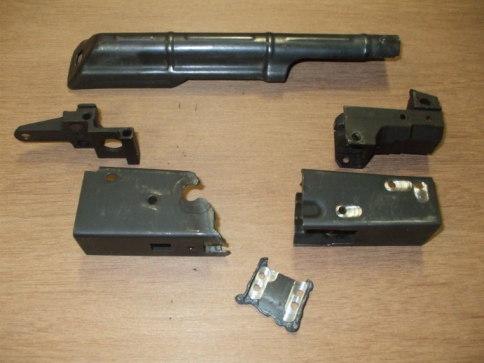
The original receiver cover, rear and front trunions, and the scraps of the torch-cut receiver. Only the front trunion counts as the "mounting block", as it is what mounts the barrel to the receiver.
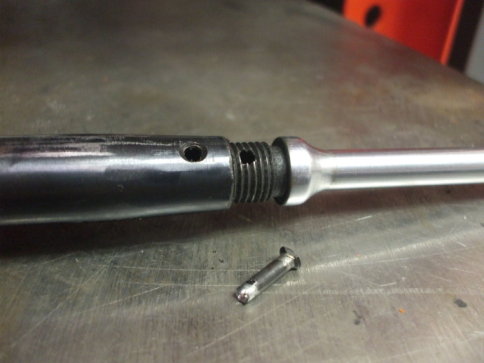
This small pin holds the gas piston in place. We drilled out the rivet at one end and pushed it out, allowing us to unscrew and replace the gas piston.
Assembling Semiautomatic Rifles and Shotguns from Imported Parts
Here is the crucial section of the Code of Federal Regulations Title 27 Volume 3 Section 478. Section 478.39 says:
|
§ 478.39 Assembly of semiautomatic rifles or shotguns. (a) No person shall assemble a semiautomatic rifle or any shotgun using more than 10 of the imported parts listed in paragraph (c) of this section if the assembled firearm is prohibited from importation under section 925(d)(3) as not being particularly suitable for or readily adaptable to sporting purposes. (b) The provisions of this section shall not apply to: (1) The assembly of such rifle or shotgun for sale or distribution by a licensed manufacturer to the United States or any department or agency thereof or to any State or any department, agency, or political subdivision thereof; or (2) The assembly of such rifle or shotgun for the purposes of testing or experimentation authorized by the Director under the provisions of §478.151; or (3) The repair of any rifle or shotgun which had been imported into or assembled in the United States prior to November 30, 1990, or the replacement of any part of such firearm. (c) For purposes of this section, the term imported parts are: (1) Frames, receivers, receiver castings, forgings or stampings (2) Barrels (3) Barrel extensions (4) Mounting blocks (trunions) (5) Muzzle attachments (6) Bolts (7) Bolt carriers (8) Operating rods (9) Gas pistons (10) Trigger housings (11) Triggers (12) Hammers (13) Sears (14) Disconnectors (15) Buttstocks (16) Pistol grips (17) Forearms, handguards (18) Magazine bodies (19) Followers (20) Floorplates [T.D. ATF-346, 58 FR 40589, July 29, 1993] |
On-line Help
GunWiki.net has a nice set of on-line tools that makes it easy to count the restricted parts in your situation.
What is an "assault weapon"? — H.R. 4296
H.R. 4296, "An Act to make unlawful the transfer or possession of assault weapons", defines the term assault weapon. This law has been allowed to expire, but this is the government's definition of the terms assault weapon and semiautomatic assault weapon. It's:
- Any of a list of nine specific models and copies or duplicates thereof,
- Or, a semiautomatic rifle with detachable magazine and at least two items from a list,
- Or, a semiautomatic pistol with detachable magazine and at least two items from a list,
- Or, a semiautomatic shotgun with at least two items from a list.
|
SECTION 2. RESTRICTION ON MANUFACTURE, TRANSFER, AND POSSESSION OF CERTAIN SEMIAUTOMATIC ASSAULT WEAPONS. (a) Restriction.--Section 922 of title 18, United States Code, is amended by adding at the end the following: (v)(1) It shall be unlawful for a person to manufacture, transfer, or possess a semiautomatic assault weapon. (2) Paragraph (1) shall not apply to the possession or transfer of any semiautomatic assault weapon otherwise lawfully possessed on the date of the enactment of this subsection. (3) Paragraph (1) shall not apply to-- (A) any of the firearms, or replicas or duplicates of the firearms, specified in Appendix A to this section, as such firearms were manufactured on October 1, 1993; (B) any firearm that-- (i) is manually operated by bolt, pump, lever, or slide action; (ii) has been rendered permanently inoperable; or (iii) is an antique firearm; (C) any semiautomatic rifle that cannot accept a detachable magazine that holds more than 5 rounds of ammunition; or (D) any semiautomatic shotgun that cannot hold more than 5 rounds of ammunition in a fixed or detachable magazine. The fact that a firearm is not listed in Appendix A shall not be construed to mean that paragraph (1) applies to such firearm. No firearm exempted by this subsection may be deleted from Appendix A so long as this Act is in effect. (4) Paragraph (1) shall not apply to-- (A) the United States or a department or agency of the United States or a State or a department, agency, or political subdivision of a State; (B) the transfer of a semiautomatic assault weapon by a licensed manufacturer, licensed importer, or licensed dealer to an entity referred to in subparagraph (A) or to a law enforcement officer authorized by such an entity to purchase firearms for official use; (C) the possession, by an individual who is retired from service with a law enforcement agency and is not otherwise prohibited from receiving a firearm, of a semiautomatic assault weapon transferred to the individual by the agency upon such retirement; or (D) the manufacture, transfer, or possession of a semiautomatic assault weapon by a licensed manufacturer or licensed importer for the purposes of testing or experimentation authorized by the Secretary.''. (b) Definition of Semiautomatic Assault Weapon.--Section 921(a) of such title is amended by adding at the end the following: (30) The term `semiautomatic assault weapon' means-- (A) any of the firearms, or copies or duplicates of the firearms, known as-- (i) Norinco, Mitchell, and Poly Technologies Avtomat Kalashnikovs (all models); (ii) Action Arms Israeli Military Industries UZI and Galil; (iii) Beretta Ar70 (SC-70); (iv) Colt AR-15; (v) Fabrique National FN/FAL, FN/LAR, and FNC; (vi) SWD M-10, M-11, M-11/9, and M-12; (vii) Steyr AUG; (viii) INTRATEC TEC-9, TEC-DC9 and TEC-22; and (ix) revolving cylinder shotguns, such as (or similar to) the Street Sweeper and Striker 12; (B) a semiautomatic rifle that has an ability to accept a detachable magazine and has at least 2 of-- (i) a folding or telescoping stock; (ii) a pistol grip that protrudes conspicuously beneath the action of the weapon; (iii) a bayonet mount; (iv) a flash suppressor or threaded barrel designed to accommodate a flash suppressor; and (v) a grenade launcher; (C) a semiautomatic pistol that has an ability to accept a detachable magazine and has at least 2 of-- (i) an ammunition magazine that attaches to the pistol outside of the pistol grip; (ii) a threaded barrel capable of accepting a barrel extender, flash suppressor, forward handgrip, or silencer; (iii) a shroud that is attached to, or partially or completely encircles, the barrel and that permits the shooter to hold the firearm with the nontrigger hand without being burned; (iv) a manufactured weight of 50 ounces or more when the pistol is unloaded; and (v) a semiautomatic version of an automatic firearm; and (D) a semiautomatic shotgun that has at least 2 of-- (i) a folding or telescoping stock; (ii) a pistol grip that protrudes conspicuously beneath the action of the weapon; (iii) a fixed magazine capacity in excess of 5 rounds; and (iv) an ability to accept a detachable magazine. |
Its section 4 bans large capacity magazines in a less complicated fashion, first prohibiting "large capacity ammunition feeding devices" and then defining them. It simply means "holds more than 10 cartridges, but not tubular magazines for .22 caliber rimfire."
|
SECTION 4. BAN OF LARGE CAPACITY AMMUNITION FEEDING DEVICES. [...] (b) Definition of Large Capacity Ammunition Feeding Device.-- Section 921(a) of such title, as amended by section 2(b) of this Act, is amended by adding at the end the following: (31) The term `large capacity ammunition feeding device'-- (A) means-- (i) a magazine, belt, drum, feed strip, or similar device that has a capacity of, or that can be readily restored or converted to accept, more than 10 rounds of ammunition; and (ii) any combination of parts from which a device described in clause (i) can be assembled; but (B) does not include an attached tubular device designed to accept, and capable of operating only with, .22 caliber rimfire ammunition. |
